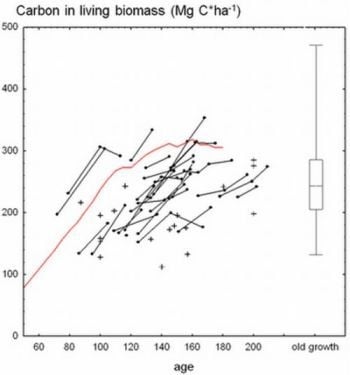The Contribution of Managed and Unmanaged Forests to Climate Change Mitigation—A Model Approach at Stand Level for the Main Tree Species in Bavaria
Abstract
:1. Introduction
- (1) What is the entire contribution of a stand (per hectare) to climate change mitigation within a time period of 180 years?
- (2) What are the differences between the four main tree species in Bavaria regarding climate change mitigation aspects?
- (3) Is the contribution of an unmanaged stand to climate change mitigation higher than a managed stand?
2. Methods
2.1. The Modeled Forest Stands
| beech | oak | spruce | pine | ||||
|---|---|---|---|---|---|---|---|
| m | um | m | m | um | m | ||
| 40 years | N (trees ha−1) | 1068 | 1082 | 733 | 1854 | 2090 | 1778 |
| BA (m² ha−1) | 24.6 | 24.5 | 18.7 | 45.0 | 57.1 | 31.2 | |
| GS (m³ ha−1) | 141 | 139 | 134 | 327 | 428 | 221 | |
| h100 (m) | 13.5 | 13.4 | 16.0 | 16.7 | 17.1 | 17.6 | |
| d100 (cm) | 19.7 | 19.6 | 20.2 | 23.4 | 23.0 | 19.3 | |
| 80 years | N (trees ha−1) | 316 | 441 | 190 | 613 | 928 | 608 |
| BA (m² ha−1) | 25.5 | 36.3 | 17.4 | 47.3 | 72.9 | 30.2 | |
| GS (m³ ha−1) | 316 | 449 | 247 | 650 | 1,016 | 387 | |
| h100 (m) | 25.3 | 25.1 | 27.7 | 30.3 | 30.5 | 30.4 | |
| d100 (cm) | 37.9 | 37.1 | 37.8 | 42.8 | 39.4 | 32.4 | |
| 120 years | N (trees ha−1) | 151 | 252 | 99 | 2147 | 450 | 310 |
| BA (m² ha−1) | 29.3 | 43.6 | 20.4 | 9.3 | 64.0 | 26.8 | |
| GS (m³ ha−1) | 524 | 770 | 374 | 25 | 1,159 | 454 | |
| h100 (m) | 34.5 | 34.2 | 33.9 | 9.2 | 40.5 | 39.1 | |
| d100 (cm) | 54.6 | 53.0 | 51.3 | 9.9 | 50.7 | 41.1 | |
| 180 years | N (trees ha−1) | 683 | 112 | 946 | 180 | 232 | 1037 |
| BA (m² ha−1) | 25.9 | 37.8 | 119 | 29.1 | 59.7 | 27.1 | |
| GS (m³ ha−1) | 202 | 864 | 21.3 | 404 | 1,290 | 233 | |
| h100 (m) | 17.0 | 43.2 | 14.6 | 30.0 | 50.8 | 21.8 | |
| d100 (cm) | 25.3 | 67.4 | 19.7 | 41.6 | 64.3 | 24.8 | |
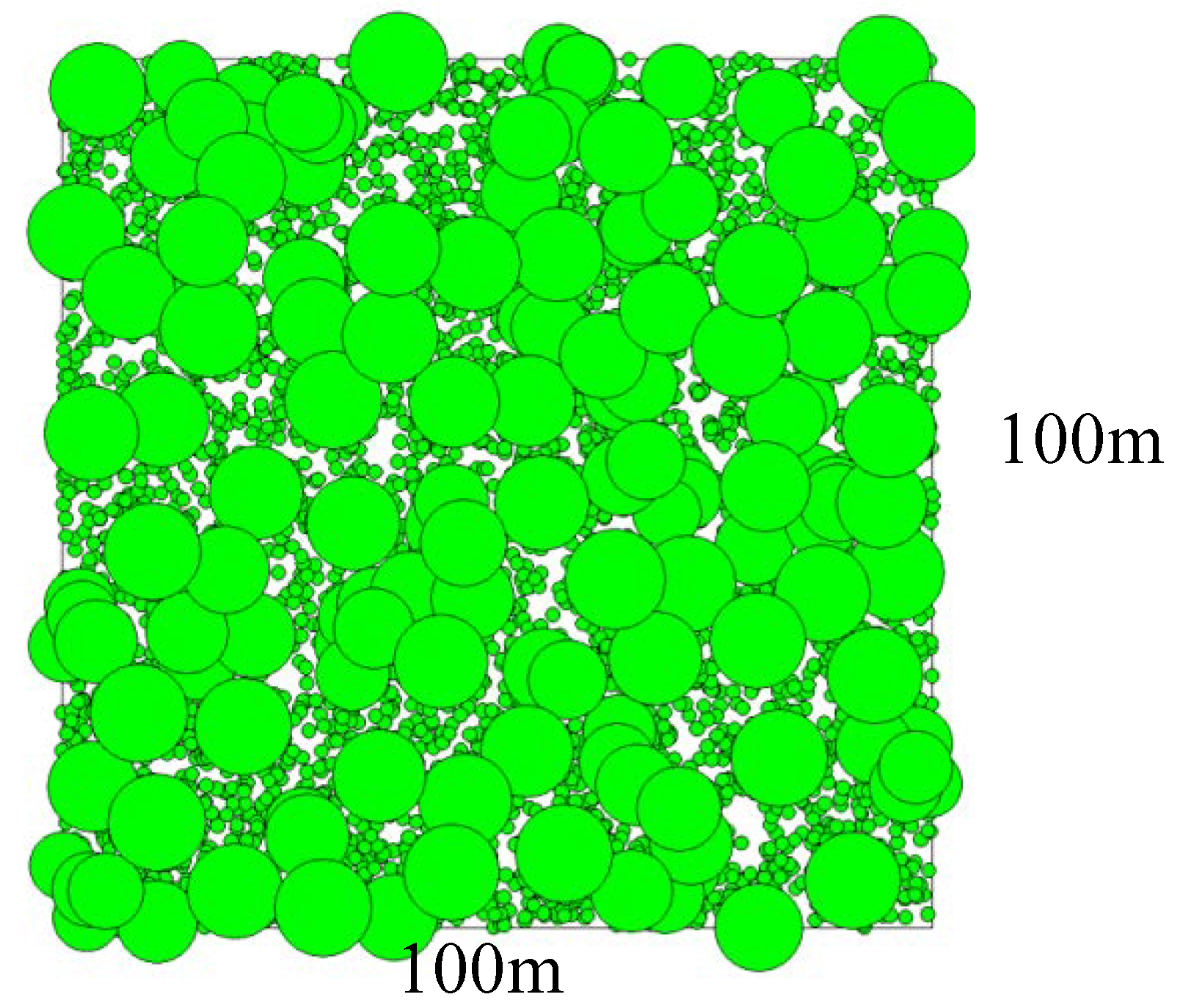
2.2. Carbon and Biomass Estimation
| biomass equation | r/s | |
|---|---|---|
| Norway spruce | AB = 0.067 × D1.938 × H0.638 | 0.22 |
| Scots pine | AB = 0.058 × D2.034 × H0.637 | 0.20 |
| Common beech | AB = 0.037 × D2.108 × H0.770 | 0.18 |
| Sessile oak | AB = 0.044 × D2.096 × H0.712 | 0.22 |
2.3. Deadwood Stock Simulation

2.4. Timber Volume and Wood Use

| amax | a95% | k | θ | |
|---|---|---|---|---|
| HWP with long lifetime (LP) (construction) | 80 | 180 | 5.15 | 19.30 |
| HWP with middle lifetime (MP) (outdoor area wood, garden, chip boards, furniture) | 15 | 40 | 3.68 | 5.42 |
| HWP with short lifetime (SP) (paper, pulpwood, packages, pallets) | 3 | 8 | 3.5 | 1.00 |
| fuel wood (F) | 1 | 9 | 1.31 | 3.50 |
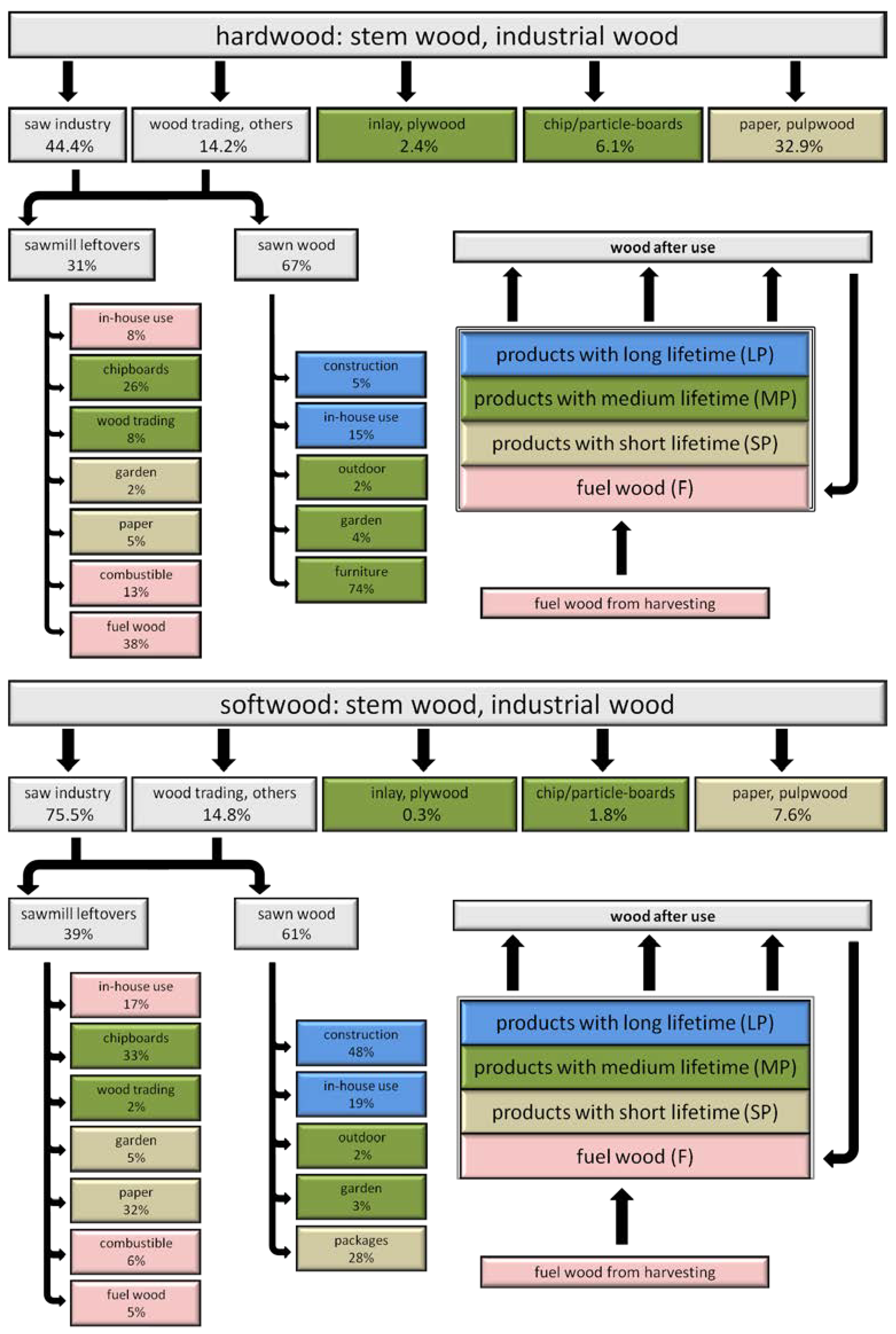

2.5. Substitution Effects of Wood Use
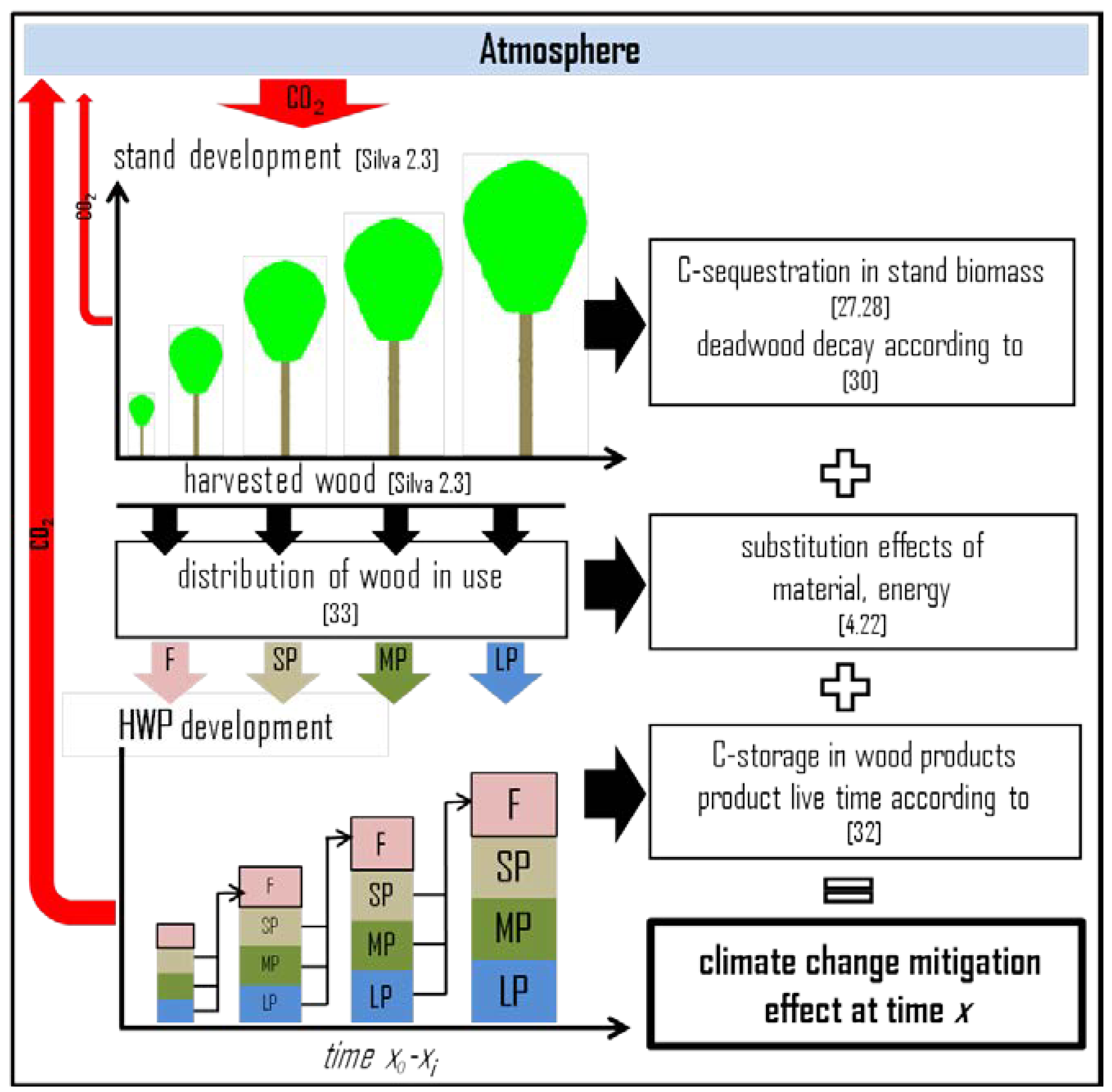
2.6. Evaluation of the Results for the Unmanaged Beech Stand
3. Results
3.1. Carbon Storage in Forest Biomass and Timber Volume in the Managed Stands
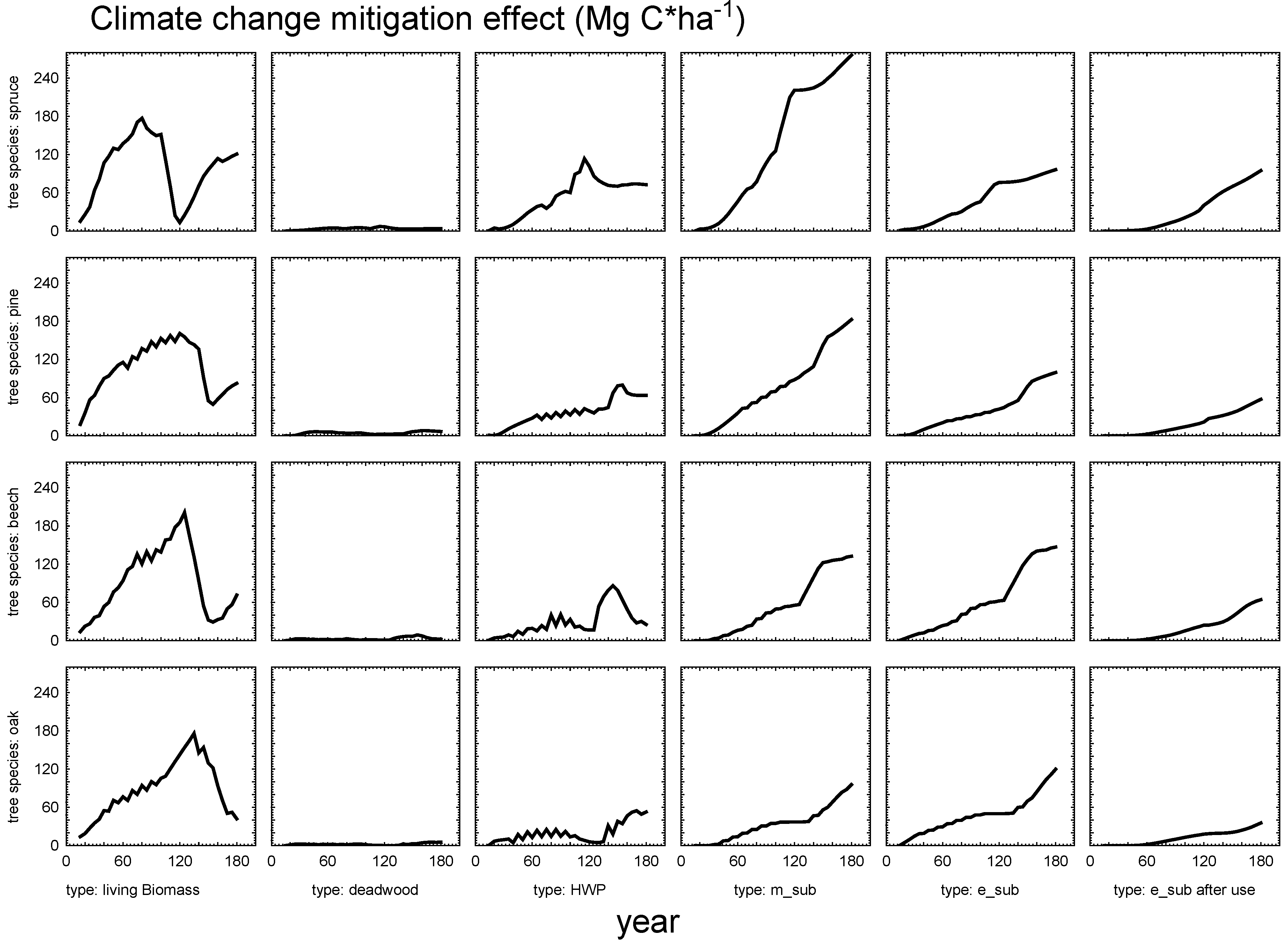
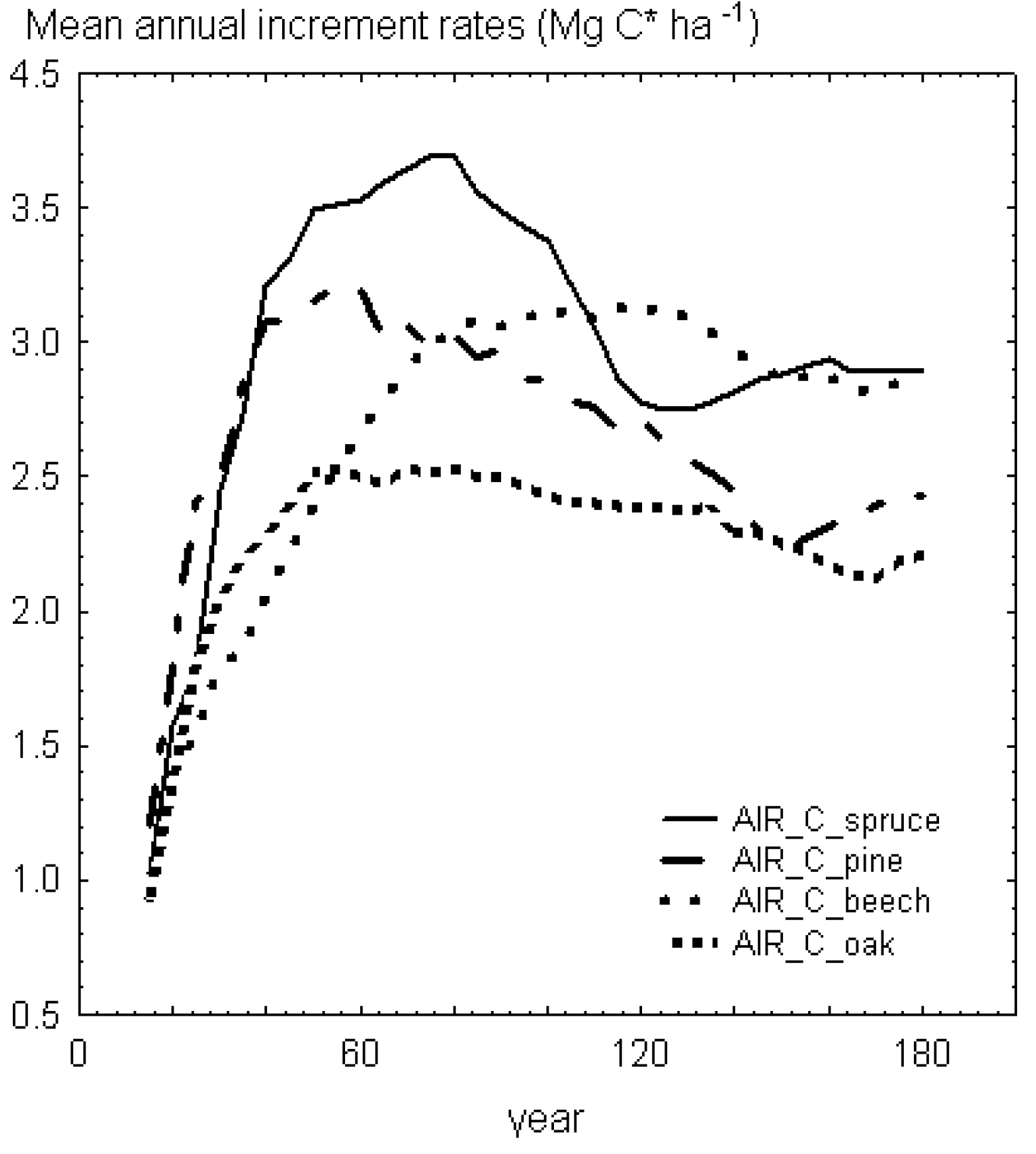
3.2. Carbon Storage in HWP and Substitution Effects in the Managed Stands
3.3. Total Climate Change Mitigation Effects in the Managed Stands
| managed | unmanaged | |||||
|---|---|---|---|---|---|---|
| spruce | pine | beech | oak | spruce | beech | |
| biomass | 0.69 | 0.50 | 0.41 | 0.26 | 2.18 | 1.92 |
| HWP | 0.40 | 0.35 | 0.14 | 0.29 | - | - |
| ∑compensation | 1.09 | 0.85 | 0.55 | 0.55 | 2.18 | 1.92 |
| m_sub | 1.53 | 1.02 | 0.74 | 0.53 | - | - |
| e_sub | 0.54 | 0.55 | 0.82 | 0.67 | - | - |
| e_sub after use | 0.53 | 0.32 | 0.36 | 0.20 | - | - |
| ∑avoidance | 2.60 | 1.89 | 1.92 | 1.40 | - | - |
| TME | 3.69 | 2.74 | 2.47 | 1.95 | 2.18 | 1.92 |
3.4. Climate Change Mitigation Effects in the Unmanaged Stands

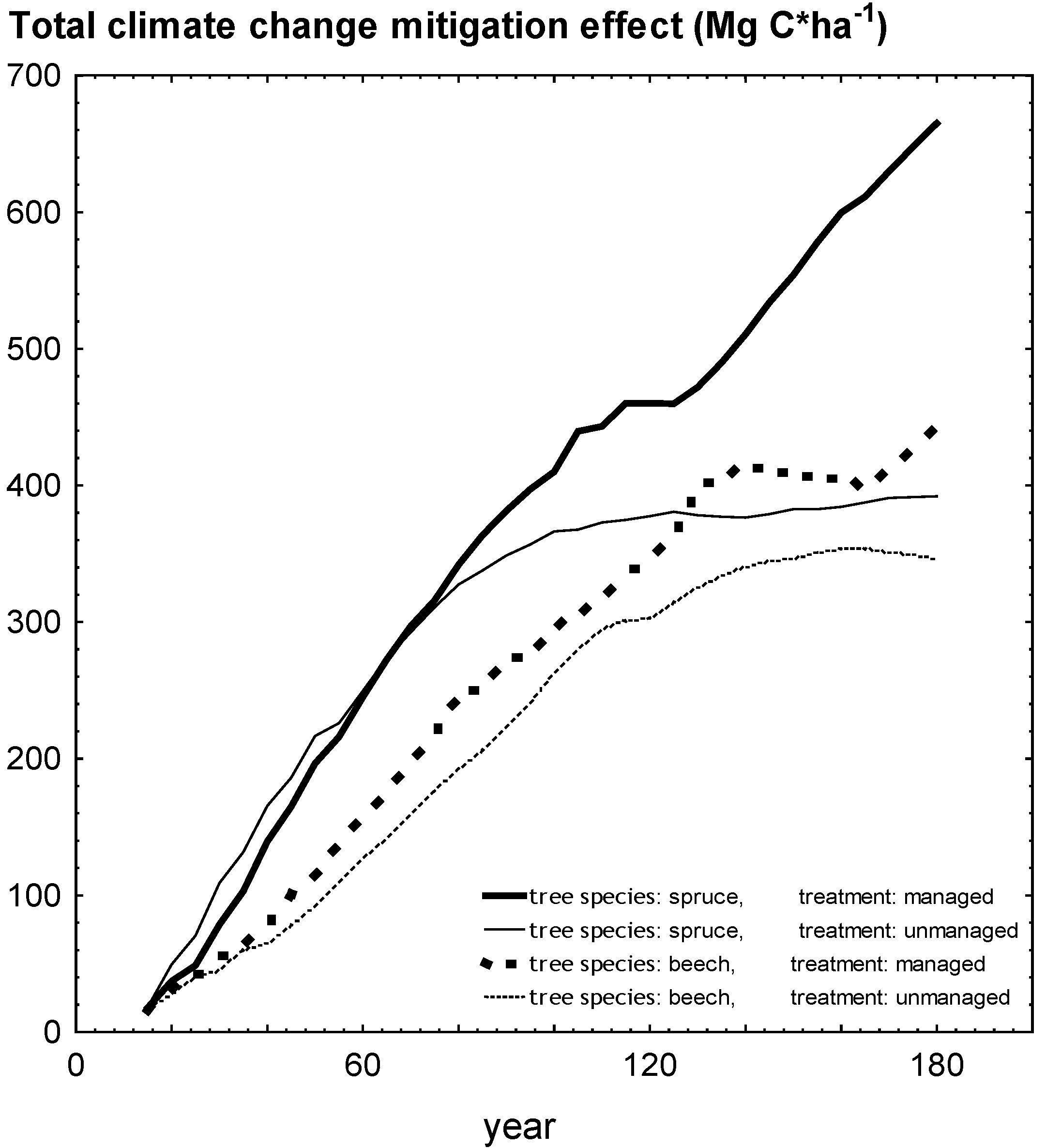
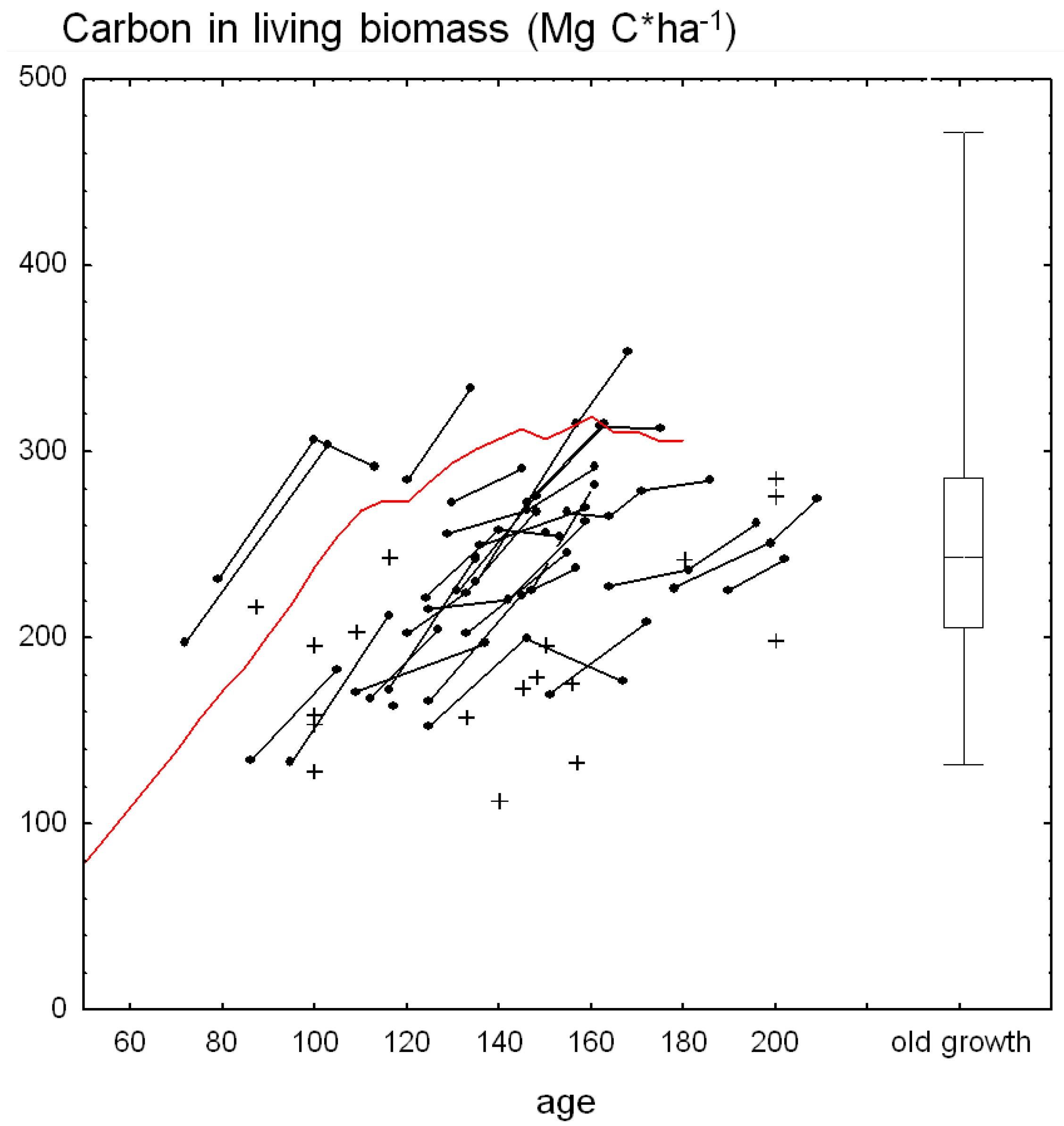
4. Discussion
4.1. The Model Assumptions
4.2. Climate Change Mitigation Effects in the Managed Stands
4.3. Climate Change Mitigation Effects in the Unmanaged Stands
4.4. Comparison between Managed and Unmanaged Stands
4.5. Possible Effects of Disturbances on the Results
4.6. Soil Carbon Sequestration
5. Conclusions
Acknowledgments
Conflict of Interest
References
- Houghton, R.A.; Hackler, J.L.; Lawrence, K.T. The U.S. carbon budget: Contributions from land-use change. Science 1999, 285, 574–578. [Google Scholar] [CrossRef]
- Nabuurs, G.J.; Thürig, E.; Heidema, N.; Armolaitis, K.; Biber, P.; Cienciala, E.; Kaufmann, E.; Mäkipää, R.; Nilsen, P.; Petritsch, R.; et al. Hotspots of the European forests carbon cycle. For. Ecol. Manag. 2008, 256, 194–200. [Google Scholar] [CrossRef]
- Schöne, D.; Schulte, A. Forstwirtschaft nach Kyoto: Ansätze zur Quantifizierung und betrieblichen Nutzung von Kohlenstoffsenken. Forstarchiv 1999, 70, 167–176. [Google Scholar]
- Köhl, M.; Frühwald, A.; Kenter, B.; Olschofsky, K.; Köhler, R.; Köthke, M.; Rüter, S.; Pretzsch, H.; Rötzer, T.; Makeschin, F.; et al. Potential und Dynamik der Kohlenstoffspeicherung in Wald und Holz: Beitrag des deutschen Forst- und Holzsektors zum Klimaschutz. vTI Agric. For. Res. Sonderheft 2009, 327, 103–109. [Google Scholar]
- Ellison, D.; Lundblad, M.; Petersson, H. Carbon accounting and the climate politics of forestry. Environ. Sci. Policy 2011, 14, 1062–1078. [Google Scholar] [CrossRef]
- Wold, C. The durban package and the goals of pacific small island developing states. American society of international law. Insights 2012, 16, 6. [Google Scholar]
- Oehmichen, K.; Demant, B.; Dunger, K.; Grüneberg, E.; Hennig, P.; Kroiher, F.; Neubauer, M.; Polley, H.; Riedel, T.; Rock, J.; et al. Inventurstudie 2008 und Treibhausgasinventar Wald; Sonderheft; Johann-Heinrich von Thünen-Institut: Hamburg, Germany, 2010; p. 343. [Google Scholar]
- Woodbury, P.B.; Smith, J.E.; Heath, L.S. Carbon sequestration in the U.S. forest sector from 1990 to 2010. For. Ecol. Manag. 2007, 241, 14–27. [Google Scholar] [CrossRef]
- Hennigar, C.R.; MacLean, D.A.; Amos-Binks, L.J. A novel approach to optimize management strategies for carbon stored in both forests and wood products. For. Ecol. Manag. 2008, 256, 786–797. [Google Scholar] [CrossRef]
- Dias, A.C.; Louro, M.; Arroja, L.; Capela, I. Comparison of methods for estimating carbon in harvested wood products. Biomass Bioenergy 2009, 33, 213–222. [Google Scholar] [CrossRef]
- Werner, F.; Taverna, R.; Hofer, P.; Richter, K. Greenhouse gas dynamics of an increased use of wood in buildings in Switzerland. Clim. Change 2006, 71, 319–347. [Google Scholar]
- Hofer, P.; Taverna, R.; Werner, F. Nutzung des geernteten Holzes—Substitution und Senkenwirkung. Schweiz. Z. Forstwes. 2008, 159, 288–295. [Google Scholar] [CrossRef]
- Pan, Y.; Birdsey, R.A.; Fang, J.; Houghton, R.; Kauppi, P.E.; Kurz, W.A.; Phillips, O.L.; Shvidenko, A.; Lewis, S.L.; Canadell, J.G.; et al. A large and Persistent carbon Sink in the world’s forests. Science 2011, 333, 988–993. [Google Scholar] [CrossRef]
- Luyssaert, S.; Ciais, S.L.; Piao, S.; Schulze, E.D.; Jung, M.; Zaehle, S.; Schelhass, M.J.; Reichstein, M.; Churkina, G.; Papale, D.; et al. The European carbon balance. Part 3: Forests. Glob. Change Biol. 2010, 16, 1429–1450. [Google Scholar] [CrossRef]
- Fürstenau, C.; Badeck, F.; Lasch, P.; Lexer, M.; Lindner, M.; Mohr, P.; Suckow, F. Multiple-use forest management in consideration of climate change and the interests of stakeholder groups. Eur. J. For. Res. 2007, 126, 225–239. [Google Scholar] [CrossRef]
- Krug, J.; Köhl, M. Bedeutung der Deutschen Forstwirtschaft in der Klimapolitik. AFZ/Der Wald 2010, 17, 30–33. [Google Scholar]
- Wirth, C.; Lichtstein, W. The Imprint of Species Turnover on Old-Growth Forests Carbon Balances- Insights From a Trait-Based Model of Forest Dynamics. In Old-Growth Forests. Function, Fate and Value; Wirth, C., Gleixner, G., Heimann, M., Eds.; Ecological Studies 207. M; Springer Verlag: Berlin Heidelberg, Germany, 2009; pp. 81–110. [Google Scholar]
- Pistorius, T.; Zell, J. Die Dynamik der Kohlenstoffvorräte in Baden-Württemberg zwischen 1987 und 2002. Veränderungen in der Waldbiomasse und Modellierung der Holzproduktspeicher. AFJZ 2005, 176, 111–120. [Google Scholar]
- Profft, I.; Mund, M.; Weber, G.E.; Weller, E.; Schulze, E.D. Forest management and carbon sequestration in wood products. Eur. J. For. Res. 2009, 128, 399–413. [Google Scholar] [CrossRef]
- Schulz, C.; Klein, D. Wald nutzen heißt Klimaschutz maximieren. LWF vergleicht verschiedene Nutzungsstrategien unter Klimaschutzaspekten. LWF Aktuell 2011, 85, 51–53. [Google Scholar]
- Moore, P.T.; DeRose, R.J.; Long, J.N.; van Miegroet, H. Using silviculture to influence carbon sequestration in southern appalachian spruce-fir forests. Forests 2012, 3, 300–316. [Google Scholar] [CrossRef]
- Hofer, P.; Taverna, R.; Werner, F.; Kaufmann, E.; Thürig, E. CO2-Effekte der Schweitzer Wald- und Holzwirtschaft. Szenarien zukünftiger Beiträge zum Klimaschutz; Bundesamt für Umwelt, BAFU: Bern, Switzerland, 2007; p. 102. [Google Scholar]
- Mund, M.; Schulze, E.D. Impacts of forest management on the carbon budget of European beech (Fagus sylvatica) forests. AFJZ 2006, 177, 47–63. [Google Scholar]
- Höllerl, S.; Neuner, M. Kohlenstoffbilanz des Wald- und Holzsektors bewirtschafteter und unbewirtschafteter Bergmischwälder der Bayerischen Alpen. Forstarchiv 2011, 82, 142–154. [Google Scholar]
- Luyssaert, S.; Schulze, E.D.; Börner, A.; Knohl, A.; Hessenmöller, D.; Law, B.E.; Ciais, P.; Grace, J. Old-growth forests as global carbon sinks. Nature 2008, 455, 213–215. [Google Scholar]
- Pretzsch, H.; Biber, P.; Ďurský, J. The single tree-based stand simulator SILVA: Construction, application, evaluation. For. Ecol. Manag. 2002, 162, 3–21. [Google Scholar]
- Zell, J. Methoden für die Ermittlung, Modellierung und Prognose der Kohlenstoffspeicherung in Wäldern auf Grundlage permanenter Großrauminventuren. PhD Dissertation, University of Freiburg i. Brsg, Freiburg i. Brsg, Germany, 2008; p. 152. [Google Scholar]
- Offenthaler, I.; Hochbichler, E. Estimation of root biomass of Austrian forest tree species. Austrian J. For. Sci. 2006, 123, 65–86. [Google Scholar]
- Burschel, P.; Kürsten, E.; Larson, B.C. Die Rolle von Wald und Forstwirtschaft im Kohlenstoffhaushalt. Eine Betrachtung für die Bundesrepublik Deutschland; Schriftenreihe. Forstwissenschaftliche Fakultät der Universität München und die Bayerische Forstliche Versuchs- und Forschungsanstalt: München, Germany, 1993; p. 135. [Google Scholar]
- Wirth, C.; Schulze, E.D.; Schwalbe, G.; Tomczyk, S.; Weber, G.; Weller, E. Dynamik der Kohlenstoffvorräte in den Wäldern Thüringens; Abschlussbericht zur 1. Phase des BMBF-Projektes, Modelluntersuchung zur Umsetzung des Kyoto-Protokolls. Thüringer Landesanstalt für Wald, Jagd und Fischerei: Gotha, Germany, 2004; p. 309. [Google Scholar]
- Rock, J.; Badeck, F.W.; Harmon, M.E. Estimating decomposition rate constants for European tree species from literature sources. Eur. J. For. Res. 2008, 127, 301–313. [Google Scholar] [CrossRef]
- Marland, E.S.; Stellar, K.; Marland, G.H. A distributed approach to accounting for carbon in wood products. Mitig. Adapt. Strateg. Glob. Change 2010, 15, 71–91. [Google Scholar]
- Röder, H.; Steinbeis, E.; Borchert, H.; Wellhausen, K.; Mai, W.; Kollert, W.; Jentsch, A.; Woest, A.; Weber-Blaschke, G.; Fiedler, S. Cluster Forst und Holz in Bayern; Ergebnisse der Clusterstudie 2008; Pöhry Forest Industry Consulting GmbH: Freising, Germany, 2008; p. 175. [Google Scholar]
- BMELV Holzmarktbericht. Abschlussbericht für die Forst- und Holzwirtschaft des Wirtschaftsjahres 2006. Anlage 1. Available online: http://www.bmelv-statistik.de/de/fachstatistiken/forst-und-holzwirtschaft/ (accessed on 19 September 2012).
- BMELV Holzmarktbericht. Abschlussbericht für die Forst- und Holzwirtschaft des Wirtschaftsjahres 2007. Anlage 1. Available online: http://www.bmelv-statistik.de/de/fachstatistiken/forst-und-holzwirtschaft/ (accessed on 19 September 2012).
- Chapter 12. Harvested Wood Products. In IPCC Guidelines for National Greenhouse Gas Inventories, 33 ed; Institute for Global Environmental Strategies: Hayama, Japan, 2006.
- Sathre, R.; O’Connor, J. A Synthesis of Research on Wood Products & Greenhouse Gas Impacts; Technical Report No. TR-19R, 2nd ed; FPInnovations: Vancouver, Canada, 2010; p. 117. [Google Scholar]
- Ingerson, A. Wood Products and Carbon Storage: Can Increased Production Help Solve the Climate Crisis? Wilderness Society: Craftsbury Common, VT, USA, 2009; p. 39. [Google Scholar]
- Lindner, M.; Karjalainen, T. Carbon inventory methods and carbon mitigation potentials of forests in Europe: A short review of recent progress. Eur. J. For. Res. 2007, 126, 149–156. [Google Scholar] [CrossRef]
- Reid, H.; Huq, S.; Inkinen, A.; MacGregor, J.; Macqueen, D.; Mayers, J.; Murray, L.; Tipper, R. Using Wood Products to Mitigate Climate Change—A Review of Evidence and Key Issues for Sustainable Management; International Institute for Environment and Development: London, UK, 2004; p. 90. [Google Scholar]
- Dietrich, H.; Jahn, H.C.; Jahn, G.; Wachter, H.; Anschütz, R.; Wagner, A. Berichte aus den Bundesländern zur Auswahl, Einrichtung und Bestandeserfassung der Naturwaldreservate. Natur und Landschaft 1980, 55, 134–143. [Google Scholar]
- Meyer, P.; Bücking, W.; Gehlhar, U.; Schulte, U.; Steffens, R. Das Netz der Naturwaldreservate in Deutschland: Flächenumfang, Repräsentativität und Schutzstatus im Jahr 2007. Forstarchiv 2007, 78, 188–196. [Google Scholar]
- Klein, D.; Schulz, C. Wälder und Holzprodukte als Kohlenstoffspeicher. Eine Betrachtung der Klimaschutzleistung der Wälder in Bayern. LWF Aktuell 2011, 85, 40–43. [Google Scholar]
- Tabaku, V.; Meyer, P. Lückenmuster albanischer und mitteleuropäischer Buchenwälder unterschiedlicher Nutzungsintensität. Forstarchiv 1999, 70, 87–97. [Google Scholar]
- Hessenmöller, D.; Schulze, E.D.; Großmann, M. Bestandesentwicklung und Kohlenstoffspeicherung des Naturwaldes “Schönstedter Holz” im Nationalpark Hainich. AFJZ 2008, 179, 209–219. [Google Scholar]
- Meyer, P. Totholzuntersuchungen in nordwestdeutschen Naturwäldern: Methodik und erste Ergebnisse. Forstwiss. Centralbl. 1999, 118, 167–180. [Google Scholar] [CrossRef]
- Meyer, P.; Menke, N.; Nagel, J.; Hansen, J.; Kawaletz, H.; Paar, U.; Evers, J. Entwicklung eines Managementmoduls für Totholz im Forstbetrieb; Abschlussbericht des von der Deutschen Bundesstiftung Umwelt geförderten Projekts; Nordwestdeutsche Forstliche Versuchsanstalt: Göttingen, Germany, 2009; p. 110. [Google Scholar]
- Müller-Using, S.; Bartsch, N. Totholzdynamik eines Buchenbestandes (Fagus silvatica L.) im Solling. Nachlieferung, Ursache und Zersetzung von Totholz. AFJZ 2003, 174, 122–130. [Google Scholar]
- Brang, P.; Heiri, C.; Bugmann, H. Waldreservate. 50 Jahre natürliche Waldentwicklung in der Schweiz. Eidgenössische Forschungsanstalt für Wald, Schnee und Landschaft WSL. Birmersdorf, ETH: Zürich, Switzerland, 2011; p. 272. [Google Scholar]
- Saniga, M.; Schütz, J.P. Dynamik des Totholzes in zwei gemischten Urwäldern der Westkarpaten im pflanzengeographischen Bereich der Tannen-Buchen- und Buchenwälder in verschiedenen Entwicklungsstadien. Schweiz. Z. Forstwes. 2001, 152, 407–416. [Google Scholar] [CrossRef]
- Korpel, S. Ergebnisse der Urwaldforschung für die Waldwirtschaft im Buchen-Ökosystem. AFZ/Der Wald 1992, 21, 1148–1152. [Google Scholar]
- Drößler, L.; von Lüpke, B. Bestandesstruktur, Verjüngung und Standortfaktoren in zwei Buchenurwald-Reservaten der Slowakei. AFJZ 2007, 178, 121–135. [Google Scholar]
- Drößler, L.; Meyer, P. Waldentwicklungsphasen in zwei Buchen-Urwaldreservaten in der Slowakei. Forstarchiv 2006, 77, 155–161. [Google Scholar]
- Trotsiuk, V.; Hobi, M.L.; Commarot, B. Age structure and disturbance of the relic virgin beech forest Uholka (Ukranian Carpathians). For. Ecol. Manag. 2012, 265, 181–190. [Google Scholar] [CrossRef]
- Werner, F.; Richter, F. Wooden building products in comparative LCA. A literature review. Int. J. LCA 2007, 12, 470–479. [Google Scholar]
- Rüter, S.; Diederichs, S. Ökobilanz-Basisdaten für Bauprodukte aus Holz; Arbeitsbericht; Institut für Holztechnologie und Holzbiologie: Hamburg, Germany, 2012; p. 304. [Google Scholar]
- Kölling, C.; Knoke, T.; Schall, P.; Ammer, C. Überlegungen zum Risiko des Fichtenanbaus in Deutschland vor dem Hintergrund des Klimawandels. Forstarchiv 2009, 80, 42–54. [Google Scholar]
- Kölling, C.; Beinhofer, B.; Hahn, A.; Knoke, T. Wie soll die Forstwirtschaft auf neue Risiken im Klimawandel reagieren? AFZ/Der Wald 2010, 5, 18–22. [Google Scholar]
- Smith, D.M.; Larson, B.C.; Kelty, M.J.; Ashton, P.M.S. The Practice of Silviculture; Applied Forest Ecology: New York, NY, USA, 1997; p. 352. [Google Scholar]
- Höllerl, S.; Bork, J. Die Kohlenstoffspeicherung von bewirtschafteten und unbewirtschafteten Fichtenbeständen unter Berücksichtigung von Ausfallrisiken—Aussagen nicht nur über Bestände der montanen Zone. Forstarchiv 2013. submitted. [Google Scholar]
- König, A. Abgrenzung von Sturmschadensrisikoklassen und Entwicklung von risikoorientierten Endnutzungsstrategien für den bayerischen Staatswald. Abschlussbericht, Projekt H8. Bayerische Landesanstalt für Wald und Forstwirtschaft: Freising, Germany, 1996; p. 54. [Google Scholar]
- Beinhofer, B. Zum Einfluss von Risiko auf den optimalen Zieldurchmesser der Fichte. Forstarchiv 2007, 78, 117–124. [Google Scholar]
- Böttcher, H.; Freibauer, A.; Scholz, Y.; Ciais, V.G.; Mund, M.; Wutzler, T.; Schulze, E.D. Setting priorities for land management to mitigate climate change. Carbon Balance Manag. 2012, 7, 18. [Google Scholar]
- Schütz, J.P. Der Plenterwald und WEITERE Formen Strukturierter und Gemischter Wälder; Parey Buchverlag: Berlin, Germany, 2001; p. 207. [Google Scholar]
- Dvorák, L.; Bachmann, P.; Mandallaz, D. Sturmschäden in ungleichförmigen Beständen. Schweiz. Z. Forstwes. 2001, 152, 445–452. [Google Scholar] [CrossRef]
- O'Hara, K.L. Multiaged forest stands for protection forests: Concepts and applications. For. Snow Landsc. Res. 2006, 80, 45–56. [Google Scholar]
- Spittlehouse, D.L.; Stewart, R.B. Adaption to climate change in forest management. BC J. Ecosyst. Manag. 2003, 4, 1–11. [Google Scholar]
- BMELV, Survey Instructions for the 2nd National Forest Inventory (2001–2002). Federal Ministry of Food, Agriculture and Consumer Protection: Bonn, Germany, 2006; p. 107.
- Christensen, M.; Hahn, K.; Mountford, E.P.; Ódor, P.; Standovár, T.; Rozenbergar, D.; Diaci, J.; Wijdeven, S.M.J.; Meyer, P.; Winter, S.; et al. Dead wood in European beech (Fagus sylvatica) forests reserves. For. Ecol. Manag. 2005, 210, 267–282. [Google Scholar] [CrossRef]
- Nunery, J.S.; Keeton, W.S. Forest carbon storage in the northeastern United States: Net effects of harvesting frequency, post-harvest retention, and wood products. For. Ecol. Manag. 2010, 259, 1363–1375. [Google Scholar] [CrossRef]
- Profft, I.; Arenhövel, W.; Seiler, M. Wald & Holz-Potential für den Klimaschutz in Thüringen. In Mitteilungen der Thüringer Landesanstalt für Wald, Jagd und Fischerei; Thüringer Landesanstalt für Wald, Jagd und Fischerei: Gotha, Germany, 2007; pp. 42–65. [Google Scholar]
- Murty, D.; Kirschbaum, M.F.; McMurtrie, R.E.; McGilvray, H. Does conversion of forest to agricultural land change soil carbon and nitrogen? A review of the literature. Glob. Change Biol. 2002, 8, 105–123. [Google Scholar] [CrossRef]
- Schulze, E.D.; Freibauer, A. Carbon unlocked from soils. Nature 2005, 437, 205–206. [Google Scholar]
- Jandl, J.; Lindner, M.; Vesterdal, L.; Bauwens, B.; Baritz, R.; Hagedorn, F.; Johnson, D.W.; Minkkinen, K.; Byrne, K.A. How strongly can forest management influence soil carbon sequestration? Geoderma 2007, 137, 253–268. [Google Scholar] [CrossRef]
- Borken, W.; Beese, F. Soil respiration in pure and mixed stands of European beech and Norway spruce following removal of organic horizons. Can. J. For. Res. 2005, 35, 2756–2764. [Google Scholar] [CrossRef]
- Knoepp, J.D.; Swank, W.T. Forest management effects on surface soil carbon and nitrogen. Soil. Sci. Soc. Am. J. 1997, 61, 928–935. [Google Scholar]
- Johnson, D.W.; Knoepp, J.D.; Swank, W.T.; Shan, J.; Morris, L.A.; van Lear, D.H.; Kapeluck, P.R. Effects of forest management on soil carbon: Results of some long-term resampling studies. Environ. Pollut. 2002, 116, 201–208. [Google Scholar] [CrossRef]
- Klein, D.; Fuentes, J.P.; Schmidt, A.; Schmidt, H.; Schulte, A. Soil organic carbon as affected by silvicultural and exploitative interventions in Nothofagus pumilio forests of the Chilenian Patagonia. For. Ecol. Manag. 2008, 255, 3549–3555. [Google Scholar] [CrossRef]
- Nave, L.E.; Vance, E.D.; Swanston, C.W.; Curtis, P.S. Harvest impacts on soil carbon storage in temperate forests. For. Ecol. Manag. 2009, 259, 857–866. [Google Scholar]
- Schulp, C.J.E.; Nabuurs, G.J.; Verburg, P.H.; de Waal, R.W. Effect of tree species on carbon stocks in forest floor and mineral soil and implications for soil carbon inventories. For. Ecol. Manag. 2008, 256, 482–490. [Google Scholar] [CrossRef]
- Gleixner, G.; Tefs, C.; Jordan, A.; Hammer, M.; Wirth, C.; Nueske, A.; Telz, A.; Schmidt, U.E.; Glatzel, S. Soil Carbon Accumulation in Old-Growth Forests. In Old-Growth Forests. Function, Fate and Value; Ecological Studies 207. M; Springer Verlag: Berlin Heidelberg, Germany, 2009; pp. 231–266. [Google Scholar]
- Schlesinger, W. Evidence from chronosequence studies for a low carbon-storage potential of soils. Nature 1990, 348, 232–234. [Google Scholar] [CrossRef]
- Reichstein, M.; Ågren, G.I.; Fontaine, S. Is There a Theoretical Limit to Soil Carbon Storage in Old-Growth Forests? A Model Analysis with Contrasting Approaches. In Old-Growth Forests. Function, Fate and Value. Ecological Studies 207. M; Wirth, C., Gleixner, G., Heimann, M., Eds.; Springer Verlag: Berlin Heidelberg, Germany, 2009; pp. 267–279. [Google Scholar]
- StMUG, Klimaprogramm Bayern 2020; Bavarian State Ministry of the Environment and Public Health: Bavarian, Germany, 2009; p. 48.
- Schmidt, M.; Glos, P. Forstlicher Hoffnungsträger: Brettschichtholz aus Buche. LWF Aktuell 2010, 7, 15–17. [Google Scholar]
© 2013 by the authors; licensee MDPI, Basel, Switzerland. This article is an open-access article distributed under the terms and conditions of the Creative Commons Attribution license (http://creativecommons.org/licenses/by/3.0/).
Share and Cite
Klein, D.; Höllerl, S.; Blaschke, M.; Schulz, C. The Contribution of Managed and Unmanaged Forests to Climate Change Mitigation—A Model Approach at Stand Level for the Main Tree Species in Bavaria. Forests 2013, 4, 43-69. https://doi.org/10.3390/f4010043
Klein D, Höllerl S, Blaschke M, Schulz C. The Contribution of Managed and Unmanaged Forests to Climate Change Mitigation—A Model Approach at Stand Level for the Main Tree Species in Bavaria. Forests. 2013; 4(1):43-69. https://doi.org/10.3390/f4010043
Chicago/Turabian StyleKlein, Daniel, Sebastian Höllerl, Markus Blaschke, and Christoph Schulz. 2013. "The Contribution of Managed and Unmanaged Forests to Climate Change Mitigation—A Model Approach at Stand Level for the Main Tree Species in Bavaria" Forests 4, no. 1: 43-69. https://doi.org/10.3390/f4010043



